Why Lord Rama is called Maryada Purushottam | What are the qualities of Maryada Purushottam? | Who is Dashrath Nandan Maryada Purushottam Ram? | Meaning of Maryada Purushottam
Namaste friends, how are you doing today? Welcome to #BhagavanBhakthi website / blog.
Bhagavan Lord Sri Vishnu (Krishna, Rama, Trivikrama, Narasimha, Vamana, Vasudeva, Mukunda) and Goddess Lakshmi (Rukmini, Satyabhama, Sita, Kamala, Maya) blessings to you and your family!
In this website / blog, you will always learn about #Hinduism #Sanskrit language.
Also subscribe to my YouTube channel from this link #BhagavanBhakthi to view videos about #Hinduism #Sanskrit language.
Just before going to “Why Lord Rama is called Maryada Purushottam | What are the qualities of Maryada Purushottam? | Who is Dashrath Nandan Maryada Purushottam Ram? | Meaning of Maryada Purushottam“, let us have a brief some brief information.
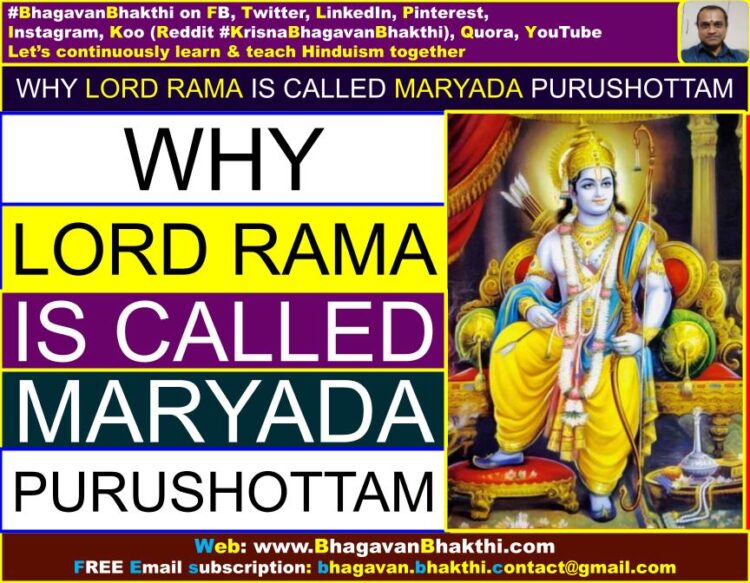
Bhagavan Lord Sri Rama was born as the 7th avatar of Bhagavan Sri Vishnu in the Dashavatar category. There is no difference between Bhagavan Sri Vishnu and Bhagavan Sri Rama, but are one and the same.
Bhagavan Sri Rama was born as the eldest son of Dasharatha Maharaja. His mother name was Sri Kausalya Devi. Dasharatha had three wives, in that Sri Kausalya Devi is the eldest.
Second wife name was Sri Sumitra Devi and third wife name was Sri Kaikeyi Devi. Bhagavan Lord Sri Rama had 3 brothers and their names are Lakshmana (Mother Sri Sumitra Devi), Bharata (Mother Sri Kaikeyi Devi) and Shatrughna (Mother Sri Sumitra Devi).

Many of us known that Bhagavan Sri Rama is called as ‘Maryada Purushottama’. But how and why? Let us know… This is because He is the best example of perfect character and human conduct, inspiring unlimited number of living beings for countless succeeding ages.
(We should always note that he is not a human. But instead, he is the Supreme Bhagavan Sri Vishnu himself. There is no different between Bhagavan Sri Vishnu and Bhagavan Sri Rama).
Whatever he was promising, he was definitely completing those works without any second question.
Why Bhagavan Lord Sri Rama is called as Maryada Purushottama?
1. In Hindu Scriptures it is said that: रामो विग्रहवान् धर्मः | ರಾಮೋ ವಿಗ್ರಹವಾನ್ ಧರ್ಮಃ | rāmō vigrahavān dharmaḥ
Meaning of the above sloka : Bhagavan Lord Sri Rama is manifestation of dharma itself and protector of Dharma.
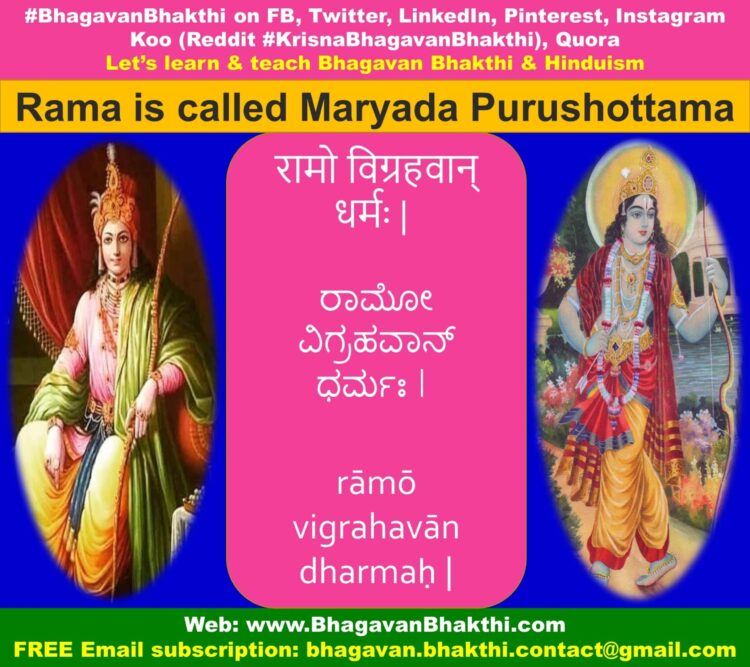
2. Bhagavan Sri Rama is dharma himself and his very nature is doing only Dharma works and his avatar is for the purpose of dharma only and nothing else.
3. Bhagavan Sri Rama is an essence of life, a personification, an avatar of Dharma itself. 4. Bhagavan Sri Rama is the very personification of righteousness.
3. Bhagavan Sri Rama is the aadi (foremost) and sarvottama (greatest) among the knower of dharma.
4. Bhagavan Sri Rama is not just a name. He and his name is a Mantra. His name ‘Sri Rama’ is the only Mantra that is called as ‘Taraka Mantra’ (तारक मंत्र / ತಾರಕ ಮಂತ್ರ / tāraka mantra).
Taraka (Tarak) Mantra means the mantra which will definitely helps us to cross the ocean of Sansar (birth and death) and will surely free us from the bondage of cycle of birth and death.
(Note: It should be noted that Sansar is different and Parivar is different. Sansar means, the cycle of birth and death. Whereas Parivar means, the family with wife, husband, children, brothers, sisters, mother, father, etc. Please don’t confuse with Sansar and Parivar. Both are different.)
5. Bhagavan Sri Rama is the one who is highly capable of keeping all the living beings with blissfulness and happiness.
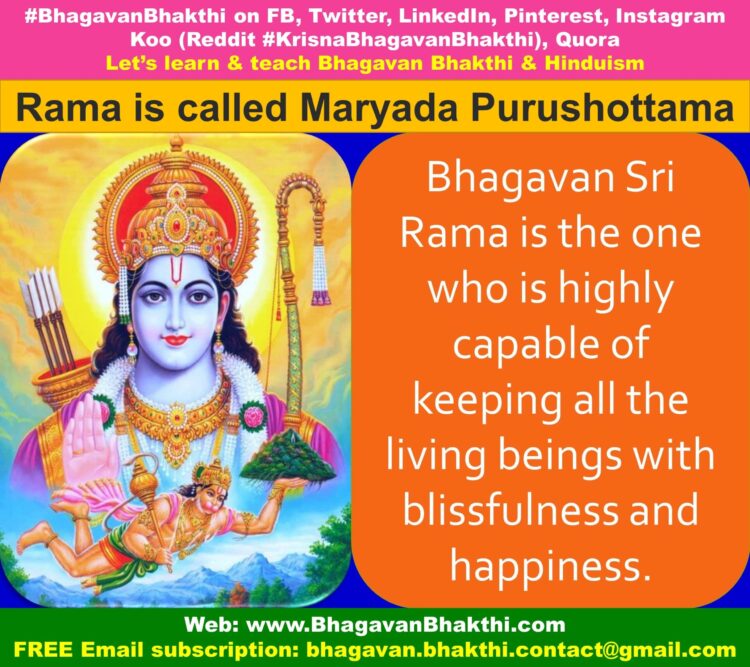
6. Bhagavan Sri Rama is the one in whose memory Yogis always reveal (take pleasure) in the delight of Supreme Brahma (Bhagavan Sri Vishnu).
7. Bhagavan Sri Rama is the supreme example of 100% perfect character and human conduct inspiring unlimited human beings for countless succeeding ages.
Let us take from Shloka from Hindu Granthas (Texts):
यत्र यत्र रघुनाथ कीर्तनं तत्र तत्र कृतमस्तकांजलिम् |
वाष्पवारि परिपूर्ण लोचनं मारुतिं नमत राक्षसान्तकम् ॥
ಯತ್ರ ಯತ್ರ ರಘುನಾಥ ಕೀರ್ತನಂ ತತ್ರ ತತ್ರ ಕೃತಮಸ್ತಕಾಂಜಲಿಮ್ |
ಭಾಷ್ಪವಾರಿ ಪರಿಪೂರ್ಣ ಲೋಚನಂ ಮಾರುತಿಂ ನಮತ ರಾಕ್ಷಸಾಂತಕಮ್ ||
yatra yatra raghunātha kīrtanaṁ tatra tatra kr̥tamastakān̄jalim |
bhāṣpavāri paripūrṇa lōcanaṁ mārutiṁ namata rākṣasāntakam ||
Meaning of the above shloka : Above shloka of Hanuman says that, “wherever Bhagavan Sri Rama nama (name) is sung with pure devotion, where Bhagavan Sri Rama is worshipped with pure love,
where Bhagavan Sri Rama’s Gunastavana (eulogizing his name and his works) is made, there, he (Hanuman Ji) is present though not visible to ordinary humans, with his eyes full of tears and with his hands folded in devotion to His Bhagavan Sri Rama“.
Hanuman Ji eulogized as the symbol of selfless service to Bhagavan Sri Rama and without a single question he is the greatest devotee of Bhagavan Sri Rama.
Hanuman Ji continuously chants this most auspicious and divine ‘Taraka mantra’ (Sri Rama) that helped him to accomplish several extraordinary feats and this happening today even.
8. Bhagavan Sri Rama is an essence of all the Vedas, Shastras, Ithihasas and Puranas etc.

9. Bhagavan Sri Rama is the one who is omniscient and full of bliss. He is the final place of rest for all the deserving souls.
10. By chanting Bhagavan Sri RamA Nama, one of the most notorious bandit (Ratnakara) of his time, got moksha / divine liberation from his sins who went on to author the great epic of Ramayana called Valmiki Ramayana.
11. Let’s consider Sri Rama Raksha stotram’s one sloka:
आपदां अपहर्तारं दातारं सर्वसम्पदाम् ।
लोकाभिरामं श्रीरामं भूयो भूयो नमाम्यहम् ॥ 35॥
ಆಪದಾಂ ಅಪಹರ್ತಾರಂ ದಾತಾರಂ ಸರ್ವಸಂಪದಾಮ್ |
ಲೋಕಾಭಿರಾಮಂ ಶ್ರೀರಾಮಂ ಭೂಯೋ ಭೂಯೋ ನಮಾಮ್ಯಹಮ್ || 35 ||
āpadāṁ apahartāraṁ dātāraṁ sarvasampadām |
lōkābhirāmaṁ śrīrāmaṁ bhūyō bhūyō namāmyaham || 35 ||
Meaning of the above shloka : You are the one who is destroyer of all dangers, you are the one who is the bestow all sorts of wealth. Thus, I again and again do namste to you Oh Bhagavan Sri Rama as you are the cynosure of eyes of all people.
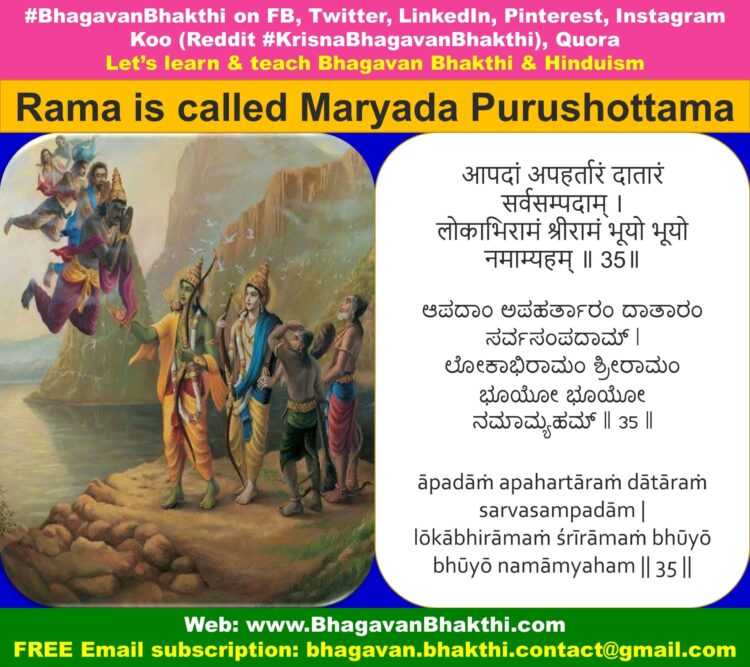
12. The great Maharshi Vashishtha meditated on Bhagavan Sri Rama nama for very long time and this gave him prerana (motivation) to suggest King Dasharatha to identify the Bhagavanta Sri Vishnu born as a child to Dasharatha (Kausalya nandanam) with the ‘Taraka mantra’ (Sri Rama) that he had chanted.
13. Lord Shiva (Hara Vaishnovottama) has eulogized Bhagavan Sri Rama and his name:
The divine glory, auspiciousness, importance, significance and merits of Bhagavan Sri Rama Nama has been eulogized by Lord Shiva by preaching the same to his dearest consort Goddess Sri Parvati Devi. (This shloka comes in Phala Shruti of Sri Vishnusahasra Nama).
श्रीराम राम रामेति रमे रामे मनोरमे ।
सहस्रनाम तत्तुल्यं रामनाम वरानने ॥ 27 ॥
ಶ್ರೀರಾಮ ರಾಮ ರಾಮೇತಿ ರಮೇ ರಾಮೇ ಮನೋರಮೇ ।
ಸಹಸ್ರನಾಮ ತತ್ತುಲ್ಯಂ ರಾಮನಾಮ ವರಾನನೇ ॥ 27 ॥
śrīrāma rāma rāmēti ramē rāmē manōramē।
sahasranāma tattulyaṁ rāmanāma varānanē॥ 27॥
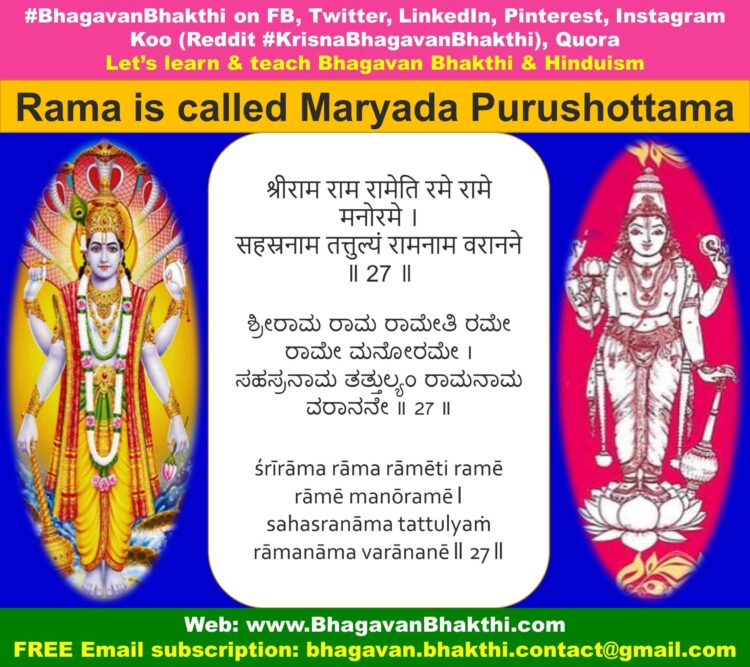
Meaning of the above shloka : “It is only the Bhagavan Sri Rama nama which is given significance as equivalent to chanting of thousand names of Vishnu.”
The divine effect of chanting Bhagavan Sri Rama nama gets multiplied in exponential number. Lord Shiva (Sri Rudra Deva) always keeps on chanting Bhagavan Sri Rama’s ‘Taraka Mantra’ (Sri RamA), that is of Maryada Purushottama.
14. Bhagavan Sri Rama is called as ‘aatma kaama’ / ‘aatma raama’:
Bhagavan Sri Rama is the one before whom, all else inclusing Goddess Sri Maha Lakshmi Devi, Sri Brahma Deva, Sri Mukhyaprana Deva, Sri Saraswati Devi, Sri Bharati Devi, Sri Rudra Deva, Sri Parvati Devi,
Sri Indra Deva, Sri Kama Deva, Sri Surya Deva, Sri Chandra Deva etc. etc. etc. becomes pale and insignificant. He is the one who has no desires for enjoyment or any luxuries and thus Bhagavan Sri Rama is called as ‘aatma kaama’ or ‘aatma raama’, as he satisfies within himself.
15. Sri Madhwacharya Ji in his Dwadasa Stotram eulogizes Bhagavan Sri Rama as:
राघव राघव राक्षस शत्रो मारुति वल्लभ जानकि कांता || 6-6 || ರಾಘವ ರಾಘವ ರಾಕ್ಷಸ ಶತ್ರೋ ಮಾರುತಿ ವಲ್ಲಭ ಜಾನಕಿ ಕಾಂತಾ || 6-6 || rāghava rāghava rākṣasa śatrō māruti vallabha jānaki kāntā || 6-6 ||
Meaning of the above shloka : Oh Raghava (Bhagavan Sri Rama), you are the shastru (enemy) of Rakshasas (Demons), you are the one who is loved by Maruti (Hanuman) and you are the affectionate of Goddess Sri Janaki Devi (Sri Sita Devi).

16. Bhagavan Sri Rama is the only Lord of Lord who creates the path to his devotees to reach the ultimate zone of Moksha (Divine liberation).
17. Bhagavan Sri Rama is an avatar and personification of all virtues, he is the ultimate divine role model as a son, as a husband, as a brother, as an able administrator, as a friend, as a King, as a human being and also as a role model for all starting from:
Goddess Sri Lakshmi Devi, Sri Brahma Deva, Sri Mukhyaprana Deva, Sri Saraswati Devi, Sri Bharati Devi, Sri Rudra Deva, Sri Parvati Devi, Sri Indra Deva, Sri Kama Deva, Sri Surya Deva, Sri Chandra Deva, etc. etc. etc.
18. Bhagavan Sri Rama is the one who wishes to do anything for his real devotees. He himself conducts, monitors and leads everybody in his world of Vaikuntha.
19. Bhagavan Sri Krishna in Bhagavad Gita (In Vibhuti Yoga):
पवनः पवतामस्मि रामः शस्त्रभृतामहम् ।
झषाणां मकरश्चास्मि स्रोतसामस्मि जाह्नवी ॥ 10-31 ॥
ಪವನಃ ಪವತಾಮಸ್ಮಿ ರಾಮಃ ಶಸ್ತ್ರಭೃತಾಮಹಂ ।
ಝಷಾಣಾಂ ಮಕರಶ್ಚಾಸ್ಮಿ ಸ್ರೋತಸಾಮಸ್ಮಿ ಜಾಹ್ನವೀ ॥ 10-31 ॥
pavanaḥ pavatāmasmi rāmaḥ śastrabhr̥tāmahaṁ।
jhaṣāṇāṁ makaraścāsmi srōtasāmasmi jāhnavī॥ 10-31॥
Meaning of the above shloka : “Amongst purifiers, I am the wind, and amongst wielders (warriors) of weapons, I am Bhagavan Sri Rama. Of water creatures, I am the crocodile, and of flowing rivers, I am the Ganges.”

(Note: We should always keep in mind that, there is no difference between Bhagavan Sri Vishnu, Bhagavan Sri Rama, Bhagavan Sri Krishna or any of his avatars. All are the one and the same.)
20. Bhagavan Sri Rama is the one who cannot be felled by anybody in the unlimited Universes. He is the most valiant and is the one who strikes terror in the hearts of evil doers. He is the greatest, the supreme most and the invincible. And all others are his followers.
21. Bhagavan Sri Rama is the leader among the celestial and is the most valorous among the brave. Above all He (Sri Rama) is ‘Hari Sarvottama’, that is, is the Supreme of the unlimited Universes.
22. Chanting Bhagavan Sri Rama Nama will free one from addictions and make one clean and get adored by others.
Bhagavan Sri Rama Nama gives one detachment and stability and never throws one off the balance at critical moments.
(Note: This doesn’t means one should not love his family, relatives, friends etc. Yes, we should love, but with detachment. Not like Dhritarashtra and Duryodhana false love.)
23. The most divine name Sri Rama will make one free from ‘raaga’ (attachment) and also ‘roga’ (disease).
24. Bhagavan Sri Rama nama smaranam is the only tool for human’s Moksha / divine liberation.
25. Bhagavan Sri Rama nama has the ultimate power of destroying sins, bestowing peace, and destroying ignorance.

As said here: रमंते सर्वे जनाः गुणैः अस्मिन् इति रामः | ರಮಂತೇ ಸರ್ವೇ ಜನಾಃ ಗುಣೈಃ ಅಸ್ಮಿನ್ ಇತಿ ರಾಮಃ | ramantē sarvē janāḥ guṇaiḥ asmin iti rāmaḥ
Meaning of the above shloka : “In whom all the people take delight for his chastity, He is Bhagavan Sri Rama.’
26. Bhagavan Sri Rama naama smaranam is the only ultimate weapon and tool for any human’s Moksha / divine liberation. Let us all make it a habit to write and / or chant on regular / daily basic the most divine taraka mantra, that is, “Sri Rama Nama”
26. Bhagavan Sri Rama is the one and only one who relieves, releases us from the cycle of birth and death, that is, Life / Sansar). This can happen only by chanting his name Sri Rama in this Kali Yuga.
27. In Sri Venkatesha Stotram (In Brahmand Purana) Bhagavan Sri Venkateshwara who is none other than Bhagavan Sri Vishnu (Bhagavan Sri Rama) himself, is eulogized as:
श्री रामो राम भद्रश्च भवबंदैक मोचकः | ಶ್ರೀ ರಾಮೋ ರಾಮ ಭದ್ರಶ್ಚ ಭವಬಂದೈಕ ಮೊಚಕಃ | śrī rāmō rāma bhadraśca bhavabandaika mocakaḥ

Meaning of the above shloka : He (Bhagavan Sri Rama) is called as ‘RamaBhadra’ and worshiping such Supreme Bhagavan is always divinely auspicious,
highly meritorious and one is always safeguarded (Bhadra) and you the one who is the consort of Goddess Sri Sita Devi, that is, Bhagavan Sri Rama.
28. Another sloka:
रामाय रामभद्राय रामचंद्राय वेधसे ।
रघुनाथाय नाथाय सीतायाः पतये नमः ॥
ರಾಮಾಯ ರಾಮಭದ್ರಾಯ ರಾಮಚಂದ್ರಾಯ ವೇಧಸೇ ।
ರಘುನಾಥಾಯ ನಾಥಾಯ ಸೀತಾಯಾಃ ಪತಯೇ ನಮಃ ।।
rāmāya rāmabhadrāya rāmacandrāya vēdhasē।
raghunāthāya nāthāya sītāyāḥ patayē namaḥ।।

Meaning of the above shloka : I do namaste (namaḥ) to Bhagavan Sri Rama (rāmāya), as you are safeguarding us (rāmabhadrāya),
you are like Sri Chandra Deva in the Suryavansh (rāmacandrāya vēdhasē), you are the ultimate among the King Raghu lineage (raghunāthāya nāthāya), you are the consort of Goddess Sri Sita Devi (sītāyāḥ patayē).
More information will be added to this on regular basis. Please this post and other posts of this website / blog to get the updated information.
To watch videos on #Hinduism #Sanskrit language, SUBSCRIBE to my YouTube channel from this link: #BhagavanBhakthi YouTube channel
To know more about Lord Rama and Ramayana, kindly click this link: Lord Rama and Ramayana
To more other pilgrimage places of India as per Hinduism, please visit this link: Pilgrimage places in India
To get more knowledge about Ekadashi and fasting, visit this link: What is Ekadashi fasting meaning and importance
Dear friends, if you need any clarifications about this post, kindly let me know, I will definitely try to answer all of them.
Also your one LIKE, one COMMENT, One Share, one SUBSCRIPTION is highly important.
This will help to know the quality of this content and also it will be helpful to know if any improvements is required for the content.
If you feel this content is useful to you and has helped you to improve your knowledge, kindly share this with your well-wishers.
Because “SHARING MEANS CARING”.
For receive FREE EMAIL SUBSCRIPTION about #BhagavanBhakthi, you can send an email to [email protected] from your email ID.
NAMASTE!
Sri Gurubhyo Namaha
Sri Krishnaaya Namaha
Sri Krishnaarpanamastu
Share in Social Media